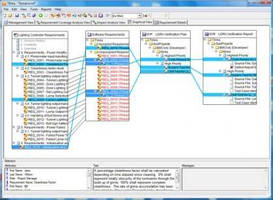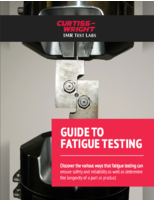Software automates requirements traceability.
Share:
Press Release Summary:

Suited for avionics, medical, defense, and nuclear industries, TBreq v3.0 provides management and automation of requirements traceability with software testing and verification. Program automatically creates requirements traceability matrix so analysts and project managers get complete picture of traceability from requirements to design, code, test specifications, and test results. All informal changes and test results are recorded, and any requirements impacted by changes are highlighted.
Original Press Release:
LDRA TBreq v3.0 Launches Next-Generation Requirements Traceability Automation
Improved traceability & verification geared to stem 60-70 percent error rate from poor requirements' management
Santa Clara, CA - March 3, 2009. (Booth 10-318), LDRA, provider of the most complete automated software testing technology with tools covering the most critical phases of the software development lifecycle, announces TBreq v3.0, which provides next-generation management and complete automation of requirements traceability with software testing and verification. For industries such as avionics, medical, defence, and nuclear where requirements traceability consumes a significant portion of project budget, TBreq v3.0 automates the management of software requirements, enabling developers to reduce software errors, project costs and resource constraints.
In business-, safety-, and security-critical industries where poor requirements management results in 60-70 percent of software errors, requirements management is essential. Requirements are an essential building block of a project, and managing changes to the verification of requirements is critical. With an easy-to-use and configurable interface, TBreq allocates requirements and verification artifacts, making them visible across a network of user workspaces. All informal changes and test results are recorded, and any requirements impacted by these changes are highlighted so that all team members can identify data which might be suspect.
Fundamental to managing software requirement changes is a requirements traceability matrix (RTM). The challenge for most companies in managing requirements comes in constructing and maintaining the RTM. The RTM typically includes project-level, customer-defined requirements that specify how the end-product should operate as well as low-level design constraints. Without an RTM, a team cannot ensure that all requirements are implemented and that all system components trace to specific requirements.
"With up to 70 percent of project defects attributed to poor requirements' administration, it's obvious that the easiest way to improve systems quality comes from learning how to manage requirements," noted Bill StClair, LDRA's Technical Evangelist. "TBreq graphically displays the links between the requirements and all other aspects of development. It becomes very easy to visually see where breakdowns have occurred, saving hours of time that would traditionally have been used debugging software and manually sorting through requirement lists."
LDRA eases requirements' administration by automatically creating the RTM with single-view, end-to-end, graphical traceability reports. Analysts and project managers get a complete picture of traceability from requirements to design, code, test specifications and test results. All reports can be exported to Microsoft Office documents and easily customized to meet project needs.
The latest release of TBreq v3.0 significantly improves ease of use by giving the user mouse-over controls at the requirement level. Intuitive project views not only provide requirement hierarchy and associated verification task visibility, but also the ability to assign users, verification groups, test case identifiers and to indicate that a requirement has been properly verified with a single mouse click.
TBreq 3.0 also makes a quantum leap in its ability to manage complex, many-to-many relationships among requirements in multiple levels in a requirements hierarchy. These complex relationships frequently occur when requirements are defined from multiple, sometimes heterogeneous, sources while still needing to be traceable through a single verification matrix. With TBreq v3.0, this matrix can be readily adapted by developers and testers so verification tasks can be performed and verification results automatically linked back to enterprise-level reports and a centralized requirements repository.
Building on technology that manually tests source code written to implement and verify requirements, the software requirements management technology integrates and automates the requirements traceability and testing/verification tasks of a distributed software development project. Having a uniform user interface helps manage highly complex and technical software development projects.
TBreq, through its integration with the LDRA tool suite, is a unique solution that can help your team overcome the challenges of allocating requirements to team members, mapping requirements to design and source code, linking test cases to requirements and generating verification reports. Activity results, including defect reports, are automatically returned to the requirements management tool and/or defect tracking tool via TBreq to provide round-trip requirements' verification.
Attendees at Embedded World can view a demonstration of TBreq v3.0 at the LDRA pavilion in Hall 10, Booth 318.
About the LDRA tool suite
The LDRA tool suite has been derived from many ground-breaking testing techniques developed by LDRA. The LDRA tool suite assists with the eight primary tasks: traceability verification, design, code and quality review, unit testing, target testing, test verification and test management. Focus on all of these key areas is required to achieve an organisation's software development and maintenance goals. The LDRA tool suite can be used by an entire project team, including developers, QA managers, test engineers, project managers and maintenance/support engineers, to automate the software development lifecycle. Through the deployment of the LDRA tool suite, companies are able to deliver well constructed, documented and tested software and benefit from significant time, cost and operational savings. For more information on the LDRA tool suite, please visit: www.ldra.com.
About LDRA
For more than thirty years, LDRA has developed and driven the market for software used for the automation of code analysis and software testing of safety-critical applications. The LDRA tool suite is used in aerospace, space and defense technology as well as the nuclear energy and automotive industries. Through the use of the LDRA tool suite, companies ensure that their systems are built in accordance with prescribed standards and are durable and reliable in use. The LDRA tool suite is available for a variety of programming languages and supports a wide range of host and target platforms. LDRA is represented world-wide with its head office in the UK and subsidiaries in the USA as well as through an extensive distributor network. For more information on the LDRA tool suite, please visit: www.ldra.com.
Please send reader enquiries to:
Mark James
LDRA, Portside, Monks Ferry, Wirral, CH41 5LH, UK
Email: mark.james@ldra.com




